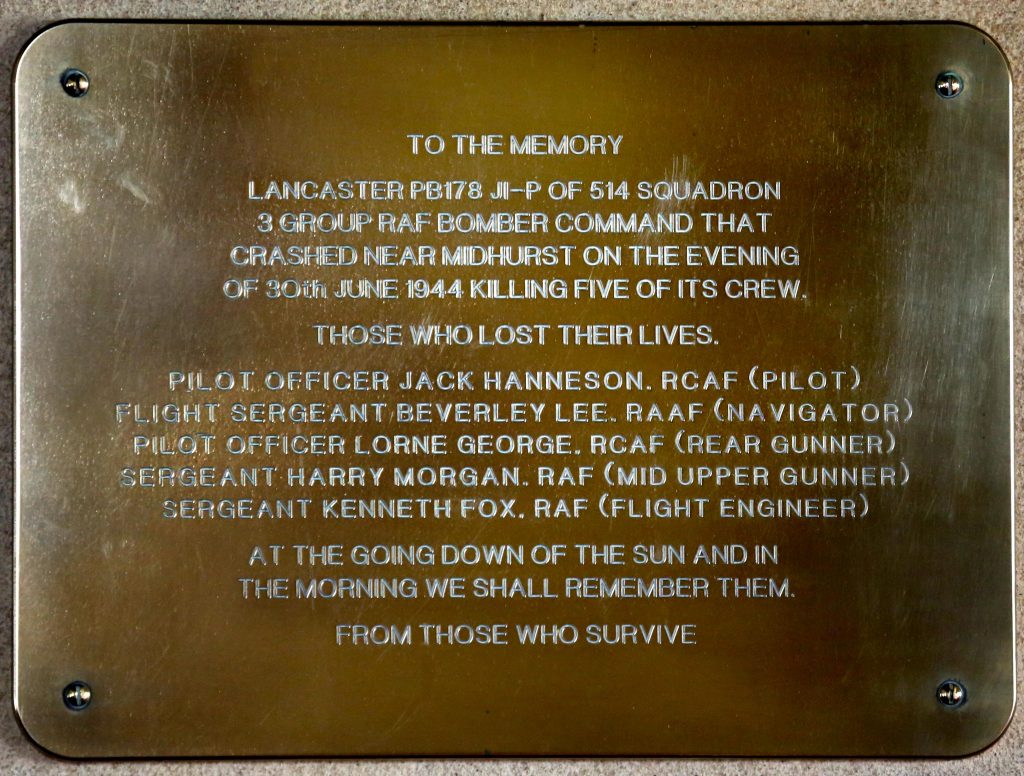
On the west wall of St. Catherine’s Church, Cocking there is a brass memorial plaque commemorating five crew members of a Lancaster bomber who were killed on 30th June 1944 in a mid-air collision over Pitsham Farm. This is their story.
In late June 1944, three weeks after the D-Day landings, the Allied forces were attempting to outflank and seize the German-occupied city of Caen. Fighting in “Operation Epsom” had lasted four days, with the allies meeting stiff resistance from the German army. On the night of 30th June, 266 heavy bombers took off from airfields across England heading for Villers-Bocage, 15 miles south-west of Caen. The small town stood on a major road junction through which two divisions of German panzers were due to pass enroute to counter-attack the allied forces.
Avro Lancaster Mark III Bomber PB178, with 21-year old Pilot Officer Jack Hannesson of the Royal Canadian Air Force at the controls, took off from RAF Waterbeach in Cambridgeshire at 18:18 to join the flotilla of aircraft heading for northern France. The aircraft had been scheduled to join the formation at Luton, but was late in taking off, and as a result missed the rendezvous time. The aircraft continued on its flight plan until it reached Sussex, where Gunner Sergeant Harry Morgan spotted a group of bombers approaching from the rear. Hannesson turned his aircraft intending to take up position when Bomber Sergeant Tom Colbeck reported that another aircraft was closing in.
In an attempt to avoid a collision, the pilot dived but unfortunately, he flew into a third aircraft, a Halifax of 15 Squadron No. PB178. At 5,000 feet above Midhurst, the tailplane of the Lancaster sliced into the Halifax.
Pilot Officer Jack Hannesson and the Flight Engineer, Sergeant Kenneth Fox were killed instantly in the collision, as was Flight Sergeant Andrew Pawlyk in the Halifax. Two of the crew of the Lancaster, Tom Colbeck and the Wireless Operator, Sergeant Bert Brown managed to bale out. They both survived with minor injuries, and were briefly treated at the King Edward VII Sanatorium.
The three remaining crew members of the Lancaster lost their lives as the plane crashed in the orchards between Pitsham Farm and Bepton.
The five men commemorated in St Catherine’s Church are:
Pilot Officer Jack Edward Kristjan Hannesson, Royal Canadian Air Force, aged 21.
Sergeant Kenneth Edward Arthur Fox, RAF Volunteer Reserve, aged 20.
Flight Sergeant Beverley Gordon Lee, Royal Australian Air Force, aged 31.
Pilot Officer Andrew Lorne George, Royal Canadian Air Force, aged 30.
Sergeant Harry James Morgan, RAF, aged 24.
The Halifax managed to reach Ford airfield where it landed safely, with the loss of the rear gunner, 22-year old Flight Sergeant Andrew Pawlyk of the Royal Canadian Air Force. The aircraft was subsequently repaired and returned to service.
After the war, Tom Colbeck joined the Vancouver Fire Department, retiring as the District chief after 36 years of service in 1982. He died in November 2013, aged 91 and was survived by three sons, two daughters and 15 grandchildren. Sadly, I have been unable to discover anything more about the other survivor, Sergeant Bert Brown of the RAF Volunteer Reserve.
Earlier that month, on 8th June, an American Air Force P-38 Lightning aircraft was returning to its base at Honington in Suffolk after a raid in France. The aircraft got into difficulty and crashed at Ball Wood on the downs above Bepton, killing the only occupant, the pilot 2nd Lieutenant Loren Wilson. In attempting to rescue the pilot, a Special Constable and Fireman were both injured by exploding ammunition. In the 1950s, children from Bepton were injured when tampering with live rounds. Children are also said to have been responsible for rolling one of the fighter’s engines down the steeply sloping side of the Downs.
June 2019